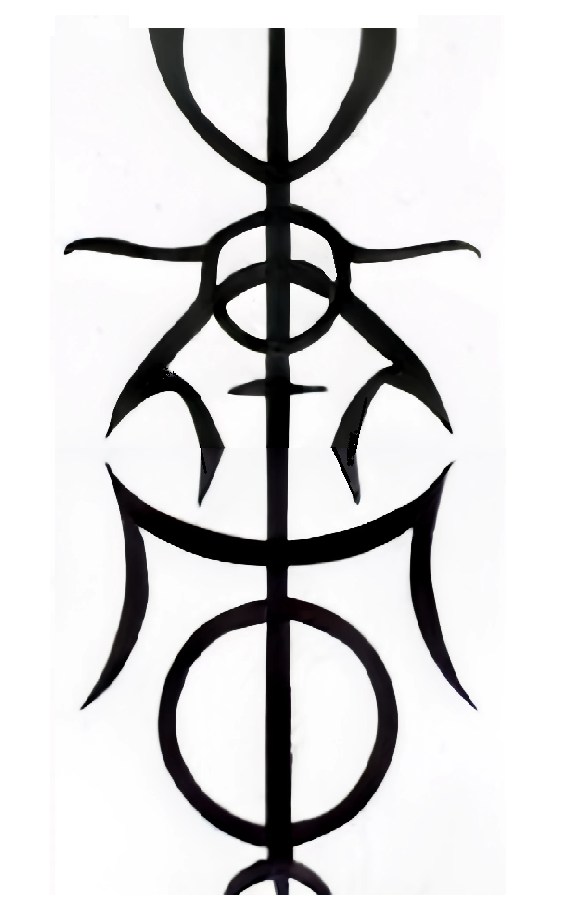The language of the
Red Men was developed by the
Entity for verbal communication, and to stifle Its subjects' ability to form complex thought and expression by restricting their speech and eliminating all other spoken tongues.
The Red Tongue is used for all forms of correspondence, and has been the glue binding the five
Dimensional communities of Red Men together. It sounds, in a paradoxical way, both beautiful and horrid to those who hear it.
History
The Entity originally intended to let Its subjects continue to use their own languages among their respective nations.
Nafir-Rin-Kur, as the new leader of the world, suggested that Old Egyptian be the lingua franca, but the disputes that arose over which human language should have preeminence annoyed the Entity to the point where It devised a simplified tongue based on Egyptian, and over time forced the new speech onto every human group from the Pacific Islands to the Americas.
Nafir offered his input into the language's core vocabulary, providing some Egyptian words for certain terms and shaping some of the phonemes. The language was revised four times by the Entity.
Writing System
The language employs a system of crude logograms and ideograms in the hundreds to convey meaning, although the Latin letters used in the English alphabet could be easily assigned to the phonemes of the Tongue. Red Men haven't figured out alphabets yet.
The most used ideogram is the abstract symbol for the Entity, written at the beginning and end of official documents to invoke Its blessing:

Sigil of the Faceless One by Kitsune Sobo
The language was first used in Dimension XXII, where the Entity made Its initial appearance. From there it spread to other Dimensions in the Vale over the course of a few thousand years.
The language has five vowels with no distinction between long or short forms:
|
Front |
Central |
Back |
| Close |
ɪ |
|
ʊ |
| Mid |
e |
|
o |
| Open |
|
ɐ |
|
And twenty-one distinct consonants:
|
Bi-Labial |
Labio-Dental |
Dental |
Alveolar |
Post-Alveolar |
Palatal |
Velar |
Glottal |
| Plosive |
p
b |
|
|
t
d |
tʃ
dʒ |
|
k
g |
|
| Nasal |
m |
|
|
n |
|
|
|
|
| Trill |
|
|
|
|
r |
|
|
|
| Fricative |
|
f
v |
θ |
s
z |
ʃ |
|
x |
h |
| Lateral Fricative |
|
|
|
ɬ |
|
|
|
|
| Approximant |
|
|
|
|
|
j |
|
|
A word is made animate by the "
i" suffix, such as
kakhan (adjective for sovereign/supreme) becoming
kakhani (ruler). All adjectives/descriptive terms end with "
an." The language has no grammatical gender.
Three cases are standard:
Nominative (a verb's subject), such as Kakhan
i (nominative singular).
Genitive (a noun which modifies another noun to indicate possession, like English "
of" or the "s" in "John
's"), such as Kakhani
syo (Ruler's, of the Ruler).
Vocative (identifies something/someone being directly addressed), such as Kakhan
e (Oh Ruler!)
Plural forms exist (such as
Kakhanir), but are used rarely and not by common folk. The case system is also not followed as religiously by regular speakers of the Tongue.
When plural forms are used, they are applied exclusively to animate nouns, which can have two endings:
Nouns ending with "
a" become "
ar" in their nominative plural form (e.g.
Yama, soul,
Yamar, souls). This noun ending is mostly dialectal, but common enough to be accepted alongside the "proper" animate suffix.
Nouns ending with "
i" are "
ir" in their nominative plural forms (e.g.
Grakhti, dancer,
Grakhtir, dancers).
With the cases there are three possible suffixes. To use Kakhani and Yama as examples:
| Case |
Singular |
Plural |
| Nominative |
Kakhani |
Kakhanir |
| Genitive |
Kakhanisyo |
Kakhanisyir |
| Vocative |
Kakhane |
Kakhanurir |
| Case |
Singular |
Plural |
| Nominative |
Yama |
Yamar |
| Genitive |
Yamarisya |
Yamarisyur |
| Vocative |
Yamer |
Yamarerar |
The Red Tongue has a very free syntax, and can be SVO or any other word order. The lower-class Red Men prefer to use SVO and the upper-class Red Men usually employ an OSV order. This dialectal class-distinction developed independent of the Entity's intervention.
The phrase "All submit to Nafir-Rin-Kur" in an upper and lower dialect:
Lower: "Khush gali olukhishgig Khajjatri Yamar!" (literally: "All lie-down foot-under Nafir-Rin-Kur's").
Upper: "Khajjatri Yamarisyur khush olukhishgig gali!" (literally: "Nafir-Rin-Kur's all foot-under lie-down").
For a Swadesh compilation of common Red Tongue words, see the Dictionary.
Words usually follow a set of five rules, including most loan words:
1) All words ending with a vowel other than "i" will have "ar" as their plural form, and all words ending with consonants will have "ir" as their plural form.
2) If words are joined together an ownership is indicated (e.g. Thi lathi, you child, versus Thilathi, your child) unless the case system is employed in place of compounding.
3) Sometimes words can have animate endings, but still be considered inanimate (such as objects or food items). The designations are foggy, and each school of Red Tongue grammar will have their own classifications of what is "living" and what is not.
4) The nominative case "animates" a noun and makes it the object of a sentence (e.g. akakhan, a descriptive term meaning "small/little", could become akakhani, "the small/little one", and be considered the object of that sentence).
5) For subjects the nominative case is paired with a verb root (e.g. Akakhaniyudi, "the little one fights"), and the verb root can be put as a prefix or suffix. So you have "doers" (subjects) and "ones things are done to" (objects) as two broad categories most words will fall into.
The sounds of the language can be replicated by the human mouth, though the combinations of phonemes would feel unusual.
In certain "upper" dialects it is more common to pronounce the "a" sound as an open back-rounded vowel ("ɒ", like the "aa" in Afrikaans "daar", or the "â" in "Fârsi"). The "e" and "i" sounds are interchangeable in the lower dialects, but this form has not gained scholarly acceptance as it would confuse the genitive and nominative cases.
There is also the frowned-upon lower dialect habit of pronouncing the "v" sound as a soft "w" (a voiced labial-velar approximant, as in French oui and English welp.
The past, present, and future tenses rely on context. A verb's position in a sentence, as well as the words surrounding it, convey what tense is appropriate in that instance. The Red Men see time as relative, and often a written message could appear to refer to both past and present events to the untrained reader.
Usually SVO or OSV, but the language was designed to be simple enough to be understood with any word order.
Certain "castes" of Red Men may have their slang and general dialectal differences, but the standardized speech used by the higher-ups in their society (found in their messages, war logs, history books, etc.) has kept the Tongue from diversifying too much.
Free-flowing, e.g. "Tashiran Kubab" (Red Earth) could also be "Kubab Tashiran" (Earth Reddish).













I really enjoy this language. It's simple and seems pretty easy to learn. And everything is interesting and I like how you can say it in any way and it makes sense (as someone who fumbles with English, I like that.)
Thank you so much! This is my first language article, so I'm glad you enjoy it :)